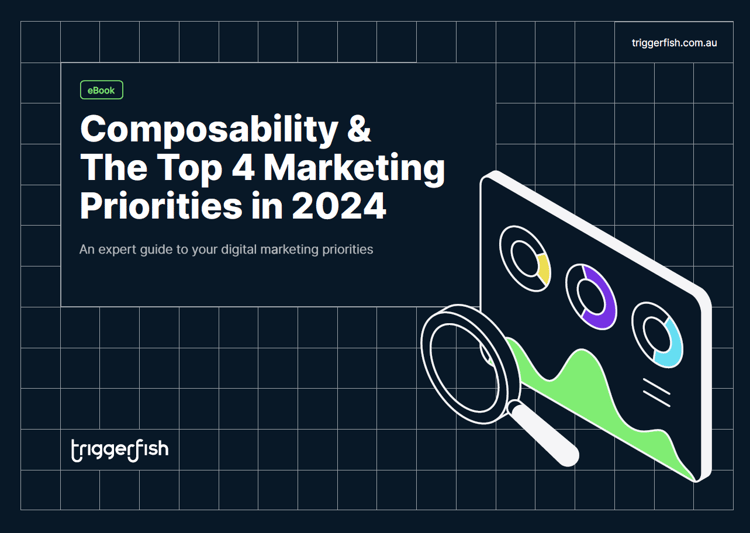Welcome to part 4 of our 5-part series that will explore the composable strategies and the top 4 marketing priorities in 2024.
With the current prominence of composable technologies, Chief Marketing Officers (CMOs), Chief Technology Officers (CTOs), and Chief Information Officers (CIOs), face a crucial business question: Are the technology-driven benefits for composable technologies aligned with business and marketing goals?According to Gartner, while composability is gaining traction, not all businesses are well-positioned to harness its full potential. Read related article Five Levels of Composability Readiness.
At Triggerfish, we’ve identified the top 4 marketing priorities that are crucial for CMOs and organisations assessing composable technologies in 2024.
These include:
- Personalisation Effectiveness
- Data-Driven Engagement
- Strategic Budget Allocation
- Modernising Team Structure
In this article, we will explore the third point above.
Budget trends and strategic MarTech investments for planning for long-term marketing tech and performance measurement
Every marketer is under pressure to optimise their spending. Boardroom discussions around budgets are not just a formality but rigorous evaluations of performance metrics, forcing CMOs to be accountable for every dollar spent.
As plans take shape for 2024, CMOs will need to effectively validate or adjust marketing investments by understanding how these decisions affect pipeline generation. According to Gartner, technology marketing teams report spending 73.3% of their overall program budget on demand-generation activities, with 49.4% being allocated to new logo demand-generation activities. Yet, the marketing team maintain a fairly large stack of technologies
as shown in the figure below.

(Source: Source: Gartner 7991115_C)
In light of composable strategies and increasing market and budget pressures, a strong focus on marketing and business objectives should be generated to ensure strategic marketing investments can be made.
Planning with market fluctuations to set baselines for talent, technology and demand generation
Effective budget forecasting is essential to anticipate and plan for cost increases, especially labour and business expenses. Historical trends show that marketing budgets have fluctuated over the years. For instance, between 2018 and 2022, marketing budgets averaged 10.9% of company revenue, but this figure dropped to 6.4% in 2021 and rose to 9.5% in 2022.
The big picture is that inflation is still reasonably high, though not as bad as in 2023.
Taking into account current economic and business pressures CMO will need to manage their budgets with respect between strategic and tactical projects.
There’s a growing inclination among customers to favour digital self-service channels, especially amidst extended sales cycles during economic uncertainty. As CMOs, it becomes imperative to reassess strategies to uphold lead engagement throughout the intricate buying cycle and the overarching customer journey.
The pivotal role of marketing in bolstering both sales and service delivery cannot be overstated.
The key lies in diversifying and optimizing channels. A strategic blend of digital channels, compelling content, and well-crafted calls to action can significantly enhance the ability to sustain a robust flow of leads. This approach not only ensures consistency in lead volume but also ensures revenue targets are hit effectively.
MarTech Consolidation and Optimisation Strategies
In today's rapidly evolving digital landscape, effective management of marketing technology is essential for business success. Implementing strategic MarTech consolidation and optimisation strategies can significantly enhance operational efficiency and maximise return on investment for marketing initiatives.
Consolidate Marketing Technologies
One of the primary strategies is to reduce technical debt by consolidating marketing
technologies. This approach involves evaluating the existing marketing technology stack and identifying areas where multiple tools may be overlapping or underutilised. By consolidating these tools or replacing them with more comprehensive solutions, organisations can reduce costs, simplify their technology landscape, and streamline operations.
Leverage Existing Investments
Optimising current technologies for maximum ROI is crucial. This involves utilising the full capabilities of existing tools and technologies rather than investing in new solutions. By doing so, companies can get more value from their existing investments, which is particularly important in an era of tightened budgets.
Triggerfish can conduct a MarTech Consolidation and Optimisation assessment to help guide your internal conversations as you formulate and prioritise strategic investments.
To continue reading about composability, download our eBook.





